Foschini Group Bundle
How Does the Foschini Group Dominate the South African Retail Scene?
The Foschini Group (TFG) is a retail powerhouse, but what does its competitive arena look like? With a diverse portfolio spanning fashion, lifestyle, and homeware, TFG navigates a dynamic market. This analysis delves into the Foschini Group SWOT Analysis, its rivals, and the strategies that fuel its continued success.
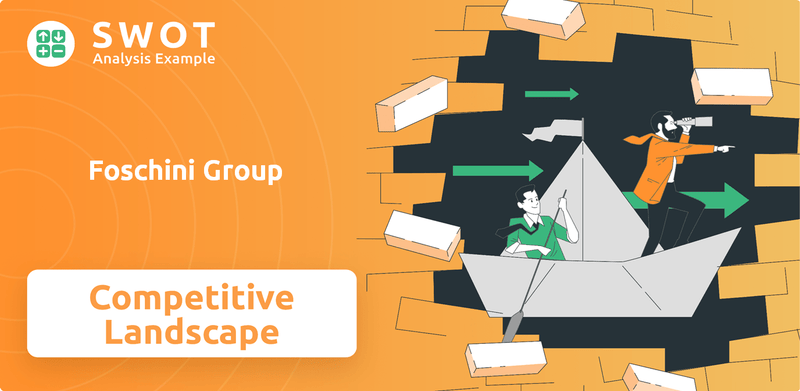
Understanding the Foschini Group's competitive landscape is crucial for investors and strategists alike. This report provides a detailed Retail Industry Analysis, exploring TFG's market share and comparing it to key Fashion Retailers. We'll dissect TFG Group's financial performance and market position to understand its competitive advantages and how it contends with rivals in the South African retail market.
Where Does Foschini Group’ Stand in the Current Market?
The Foschini Group (TFG) maintains a robust market position within the South African retail industry, serving as a key player in the competitive landscape. TFG's operations are primarily focused on fashion, lifestyle, and homeware, with a diverse portfolio of brands catering to a broad customer base. The company's strategic approach includes a blend of physical stores and a growing online presence, reflecting its adaptability to evolving market trends.
For the nine months ending December 31, 2024, TFG reported a retail turnover of R30.2 billion, illustrating its significant scale and market presence. This financial performance underscores TFG's ability to navigate the complexities of the retail industry and maintain a strong competitive edge. The company's focus on both local manufacturing and digital transformation further strengthens its position.
TFG's core operations center around its extensive network of stores and its diverse brand portfolio. The company's value proposition lies in offering a wide range of products, from clothing and footwear to homeware, at various price points. This strategy allows TFG to capture a larger segment of the market, appealing to both budget-conscious consumers and those seeking premium products. TFG's commitment to local manufacturing and digital innovation enhances its value proposition, making it a more resilient and competitive player in the market.
TFG's market share is substantial, driven by its strong financial performance. The company's retail turnover for the nine months ended December 31, 2024, reached R30.2 billion, reflecting its dominance in the South African retail market. TFG Africa, the largest segment, contributed significantly to this growth, with a 10.9% increase in retail turnover, reaching R24.4 billion.
TFG's brand portfolio is diverse, including popular clothing retailers like Markham and Sportscene, and homeware brands such as Coricraft. This diverse portfolio allows TFG to cater to a wide range of customers, from budget-conscious consumers to those seeking premium offerings. The company's strategic diversification has been key to its market position.
TFG's operational footprint is extensive, with a total of 3,592 stores across all its trading territories as of December 31, 2024. The company continues to expand, opening 126 new stores in TFG Africa during the same period. This expansion strategy, combined with a focus on digital transformation, enhances its market reach.
TFG is actively pursuing digital transformation to enhance its market position. Online turnover for TFG Africa grew by 14.8% for the nine months ended December 31, 2024, demonstrating the company's commitment to e-commerce. This focus on digital channels complements its physical store network, providing a hybrid approach to customer engagement.
TFG's competitive advantages include its diverse brand portfolio, extensive store network, and focus on both physical and digital retail channels. The company's ability to adapt to changing market trends, such as the growing demand for online shopping, is a key factor in its success. Furthermore, TFG's commitment to local manufacturing strengthens its supply chain and responsiveness to local market demands, with 72.8% of TFG Africa's apparel now locally manufactured.
- Strong financial performance with a retail turnover of R30.2 billion for the nine months ended December 31, 2024.
- Significant growth in TFG Africa, with a 10.9% increase in retail turnover.
- Expansion of store network, with 126 new stores opened in TFG Africa.
- Growing online presence, with online turnover in TFG Africa increasing by 14.8%.
- Commitment to local manufacturing, with 72.8% of apparel locally manufactured.
For more insights into how TFG approaches its marketing strategies, consider reading about the Marketing Strategy of Foschini Group.
Foschini Group SWOT Analysis
- Complete SWOT Breakdown
- Fully Customizable
- Editable in Excel & Word
- Professional Formatting
- Investor-Ready Format
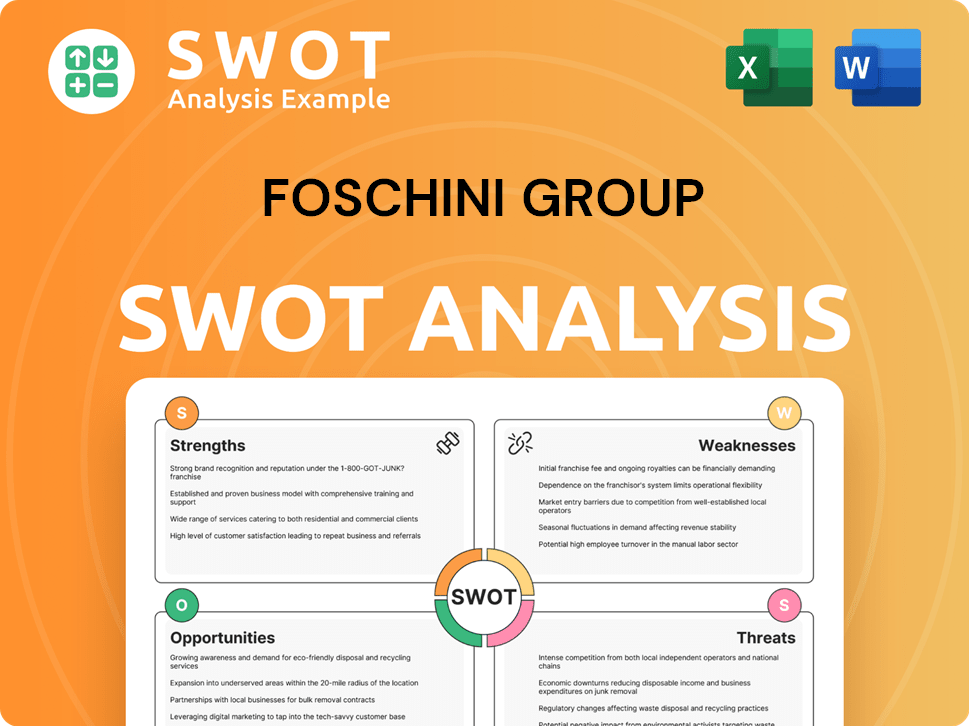
Who Are the Main Competitors Challenging Foschini Group?
The Foschini Group (TFG) operates within a dynamic and multifaceted competitive landscape. Understanding the competitive landscape is crucial for assessing the company's market position and strategic responses. This analysis considers both direct and indirect competitors across its diverse portfolio of brands and retail segments, providing a comprehensive overview of the challenges and opportunities TFG faces.
The TFG Company confronts competition from established players and emerging trends, including the rise of e-commerce and the impact of international retailers. The analysis of the Foschini Group's competitive environment involves a detailed examination of key rivals, market dynamics, and the strategies needed to maintain and enhance its market share. This involves analyzing the Retail Industry Analysis and understanding its impact on the company's performance.
The South African retail sector is subject to various economic factors, consumer behavior changes, and technological advancements. These factors influence the competitive dynamics within the fashion, homeware, and mobile sectors, requiring TFG to adapt and innovate continuously. For a deeper understanding, explore the Target Market of Foschini Group to gain insights into customer demographics and market positioning.
Key direct competitors in the fashion and apparel sector include Truworths, Woolworths, and Mr Price Group. These retailers compete directly with TFG's brands, such as Markham and Sportscene, offering similar product categories and targeting comparable customer segments. Truworths focuses on fashion-forward clothing, while Woolworths offers a broader range of quality apparel.
Indirect competition comes from international fast-fashion retailers like H&M and Zara, which have expanded into the South African market. These brands challenge TFG's fashion brands through rapid trend cycles and global supply chains. The rise of e-commerce platforms also poses a significant threat.
In the homeware segment, TFG's brands compete with Lewis Group, Shoprite's House & Home, and independent furniture and décor stores. These competitors offer a range of furniture, décor, and household items, directly challenging TFG's market share in this sector. They also compete with brands like Coricraft and Volpes.
The mobile and jewelry sectors have their own specialized competitors, including large electronics retailers and independent jewelers. These competitors offer a wide variety of products and services, challenging TFG's brands in these specific market segments. This requires a focus on innovation and customer service.
E-commerce platforms like Zando (part of Jumia) and Superbalist (part of Takealot) compete directly with TFG's growing online presence. These online retailers offer convenience and a wide selection of products, impacting TFG's digital sales. This necessitates strategic investments in e-commerce capabilities and digital marketing.
Emerging players and smaller online-only retailers are constantly disrupting the traditional competitive landscape, often leveraging niche markets or innovative digital strategies. These agile competitors can quickly gain market share, requiring TFG to stay adaptable and responsive to new trends and technologies. The retail landscape is always changing.
The competitive landscape requires TFG to remain adaptable and strategically responsive. This involves continuous monitoring of market trends, consumer preferences, and competitor activities. Ongoing consolidation within the retail sector further reshapes competitive dynamics, increasing the need for strategic agility.
- Market Share TFG: TFG's market share is influenced by its ability to differentiate its brands and respond to competitive pressures.
- Foschini Group market position analysis: Regular analysis of its market position is essential for maintaining and improving its competitive advantage.
- How does Foschini Group compete in the fashion industry?: TFG competes by offering a diverse brand portfolio, focusing on customer experience, and leveraging its supply chain.
- South African retail market trends: Understanding the latest trends is crucial for making informed strategic decisions and adapting to changing consumer needs.
Foschini Group PESTLE Analysis
- Covers All 6 PESTLE Categories
- No Research Needed – Save Hours of Work
- Built by Experts, Trusted by Consultants
- Instant Download, Ready to Use
- 100% Editable, Fully Customizable
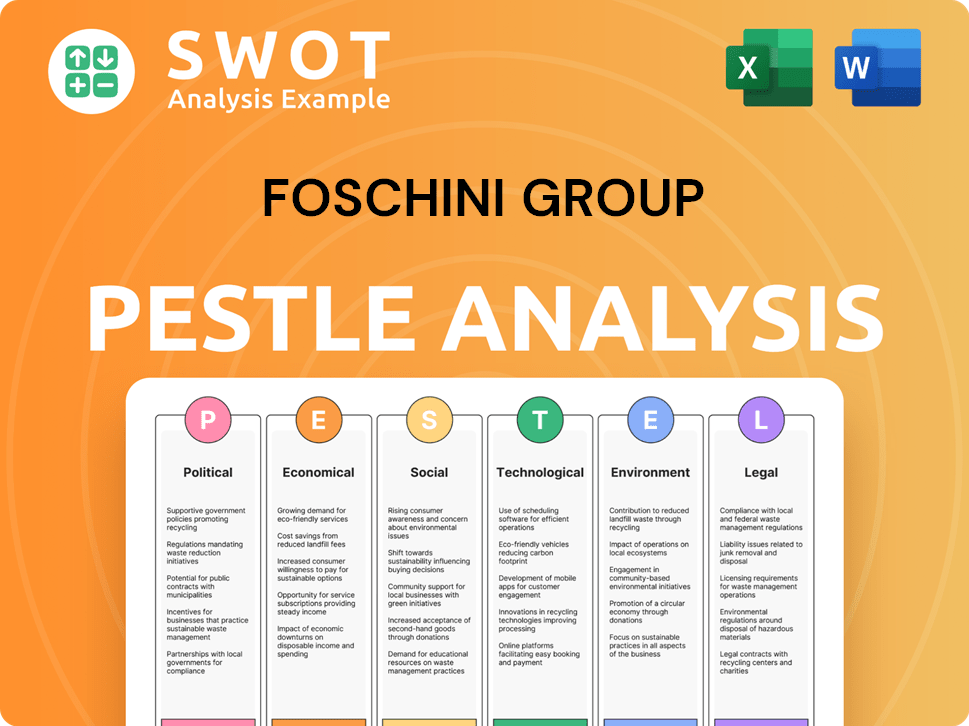
What Gives Foschini Group a Competitive Edge Over Its Rivals?
The Foschini Group (TFG) maintains a strong position in the competitive landscape of the retail industry. A deep dive into the TFG Company reveals several key competitive advantages. These strengths allow the company to navigate the dynamic retail environment effectively.
Foschini Group leverages its extensive brand portfolio, robust omnichannel strategy, and increasing focus on local manufacturing. These factors contribute to its sustained success. The company's ability to adapt to changing consumer preferences and market trends is also crucial.
The Retail Industry Analysis shows that TFG's strategic initiatives are designed to enhance customer engagement and expand market reach. The company's financial performance reflects the effectiveness of these strategies. It is important to understand the competitive advantages of TFG to assess its long-term growth potential.
TFG's diverse brand portfolio is a key competitive advantage. It includes over 30 retail brands across fashion, lifestyle, and homeware. This enables TFG to cater to a wide range of consumers, mitigating risks.
TFG's omnichannel strategy integrates its physical stores with its e-commerce platform. Online turnover for TFG Africa grew by 14.8% for the nine months ended December 31, 2024. This approach enhances customer experience and expands market reach.
TFG's focus on local manufacturing provides a significant operational advantage. For the nine months ended December 31, 2024, 72.8% of TFG Africa's apparel was locally manufactured. This strategy reduces reliance on international supply chains.
TFG's established credit offering supports a broader customer base. This offering fosters customer loyalty through convenient payment options. This provides a competitive edge in the South African market.
The Competitive Landscape for TFG is shaped by several key advantages. These advantages include a diversified brand portfolio and a strong omnichannel presence. TFG's strategic moves, such as increasing local manufacturing, contribute to its resilience.
- Extensive Brand Portfolio: Over 30 retail brands across fashion, lifestyle, and homeware.
- Omnichannel Strategy: Integration of e-commerce and physical stores.
- Local Manufacturing: 72.8% of apparel locally manufactured.
- Customer Loyalty: Established credit offerings.
Foschini Group Business Model Canvas
- Complete 9-Block Business Model Canvas
- Effortlessly Communicate Your Business Strategy
- Investor-Ready BMC Format
- 100% Editable and Customizable
- Clear and Structured Layout
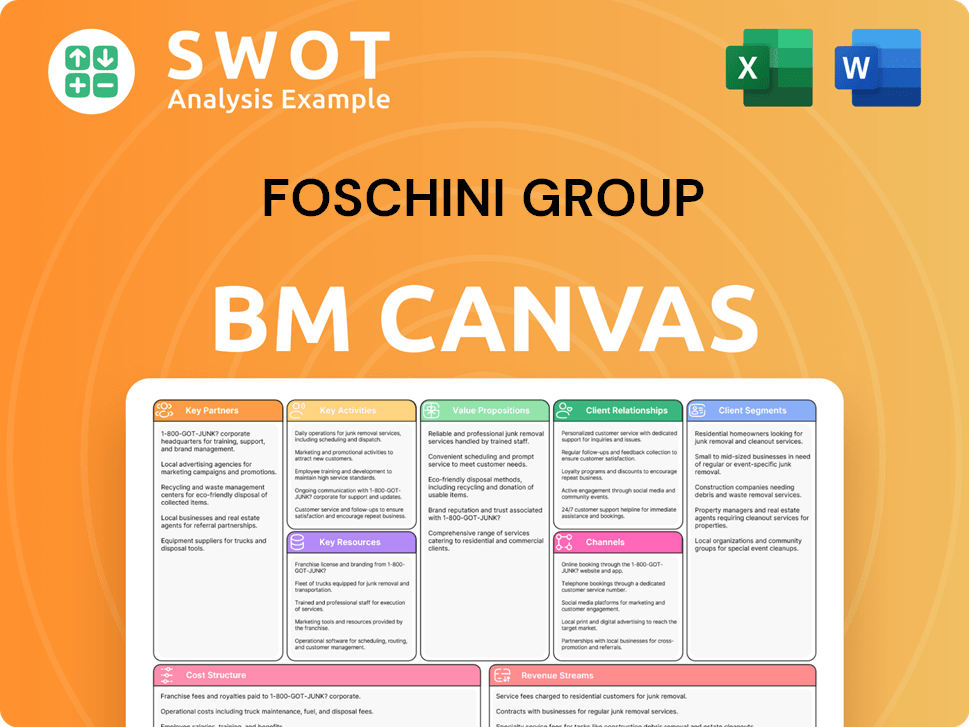
What Industry Trends Are Reshaping Foschini Group’s Competitive Landscape?
The retail industry, a dynamic sector, is currently experiencing significant shifts. These changes present both challenges and opportunities for The Foschini Group (TFG), a prominent player in the market. Understanding the competitive landscape is crucial for TFG's strategic planning and sustained growth.
The competitive landscape of TFG is influenced by technological advancements, changing consumer preferences, and economic factors. Adapting to these trends is essential for maintaining market share and achieving financial success. For instance, TFG's online turnover growth indicates its responsiveness to e-commerce trends, but it must also manage the challenges associated with this shift.
E-commerce is reshaping consumer behavior, requiring continuous investment in digital platforms. Sustainability and ethical sourcing are becoming increasingly important to consumers. Economic shifts such as fluctuating exchange rates impact consumer spending and operational costs. TFG's 14.8% growth in online turnover for TFG Africa for the nine months ended December 31, 2024, demonstrates a positive response to these trends.
Geopolitical uncertainties can disrupt global supply chains. Rising operational costs, including energy and labor, pose a challenge. Intensified competition from international retailers in African markets is a significant threat. The challenging consumer environment, as noted in the nine months ended December 31, 2024, puts pressure on disposable income.
Expanding into underserved African markets offers substantial growth potential. Leveraging data analytics to personalize customer experiences and optimize inventory management can enhance profitability. Innovation in product offerings can capture new market shares. Strategic partnerships could unlock new revenue streams and operational efficiencies.
TFG demonstrated resilience with a 6.7% retail turnover growth in the nine months ended December 31, 2024. The company's focus on local manufacturing mitigates supply chain risks and aligns with national economic goals. TFG's ability to adapt to evolving trends through strategic agility and customer-centric innovation is crucial. For more insights, explore the Brief History of Foschini Group.
TFG must navigate the complexities of the retail industry by focusing on several key areas. These include adapting to e-commerce demands, meeting consumer expectations for sustainability, and managing operational costs. The company's strategic initiatives should consider both the challenges and opportunities present in the market.
- Investing in digital platforms and supply chain efficiency.
- Adapting sourcing and production to meet sustainability demands.
- Monitoring and responding to economic shifts.
- Expanding into new markets in Africa.
- Leveraging data analytics for improved customer experience.
Foschini Group Porter's Five Forces Analysis
- Covers All 5 Competitive Forces in Detail
- Structured for Consultants, Students, and Founders
- 100% Editable in Microsoft Word & Excel
- Instant Digital Download – Use Immediately
- Compatible with Mac & PC – Fully Unlocked
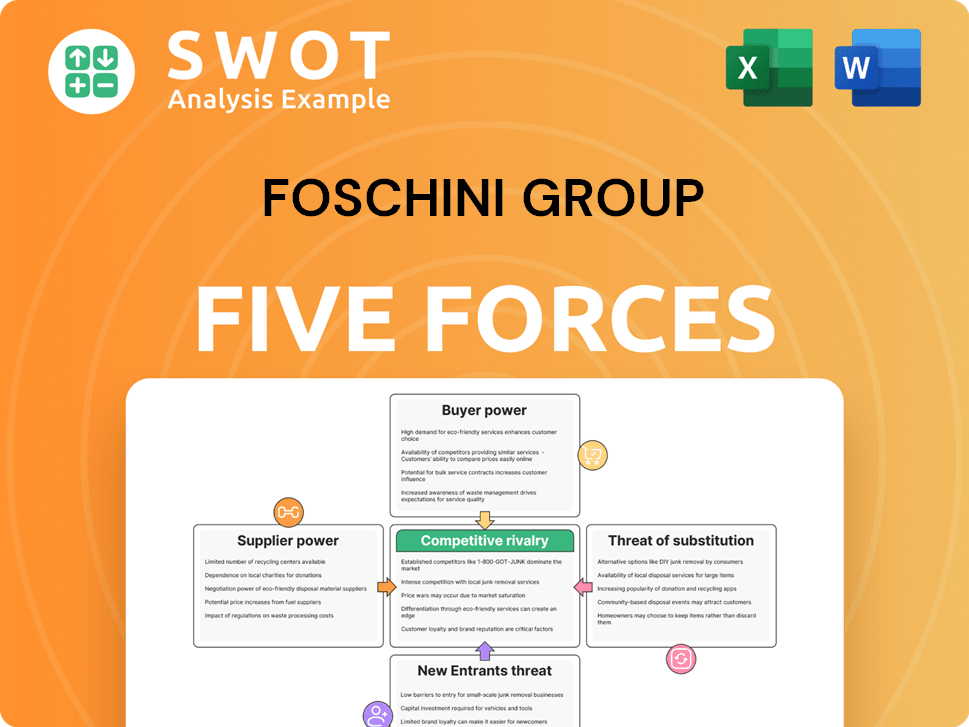
Related Blogs
- What are Mission Vision & Core Values of Foschini Group Company?
- What is Growth Strategy and Future Prospects of Foschini Group Company?
- How Does Foschini Group Company Work?
- What is Sales and Marketing Strategy of Foschini Group Company?
- What is Brief History of Foschini Group Company?
- Who Owns Foschini Group Company?
- What is Customer Demographics and Target Market of Foschini Group Company?
Disclaimer
All information, articles, and product details provided on this website are for general informational and educational purposes only. We do not claim any ownership over, nor do we intend to infringe upon, any trademarks, copyrights, logos, brand names, or other intellectual property mentioned or depicted on this site. Such intellectual property remains the property of its respective owners, and any references here are made solely for identification or informational purposes, without implying any affiliation, endorsement, or partnership.
We make no representations or warranties, express or implied, regarding the accuracy, completeness, or suitability of any content or products presented. Nothing on this website should be construed as legal, tax, investment, financial, medical, or other professional advice. In addition, no part of this site—including articles or product references—constitutes a solicitation, recommendation, endorsement, advertisement, or offer to buy or sell any securities, franchises, or other financial instruments, particularly in jurisdictions where such activity would be unlawful.
All content is of a general nature and may not address the specific circumstances of any individual or entity. It is not a substitute for professional advice or services. Any actions you take based on the information provided here are strictly at your own risk. You accept full responsibility for any decisions or outcomes arising from your use of this website and agree to release us from any liability in connection with your use of, or reliance upon, the content or products found herein.